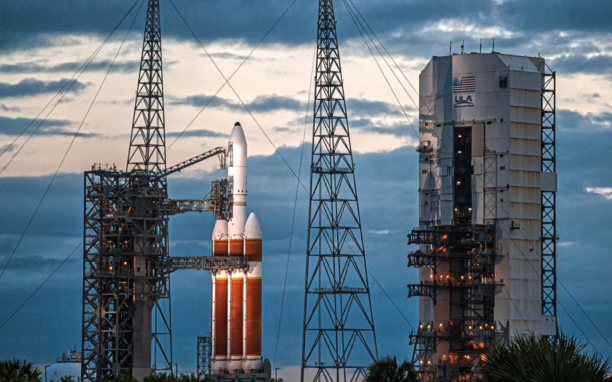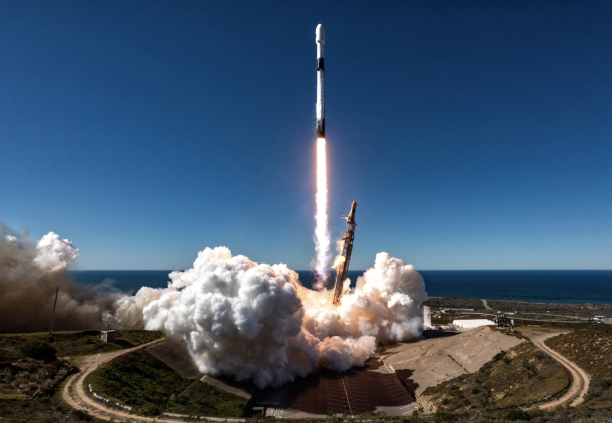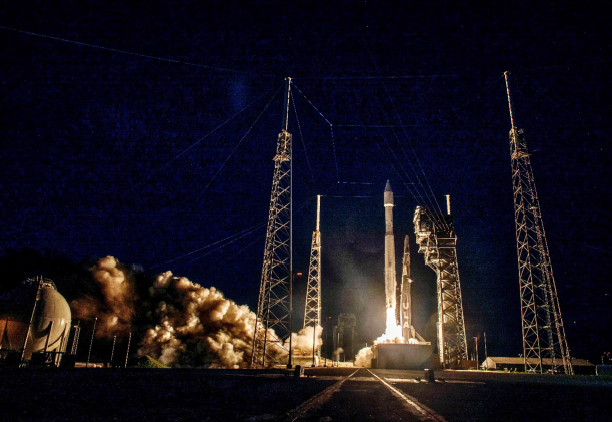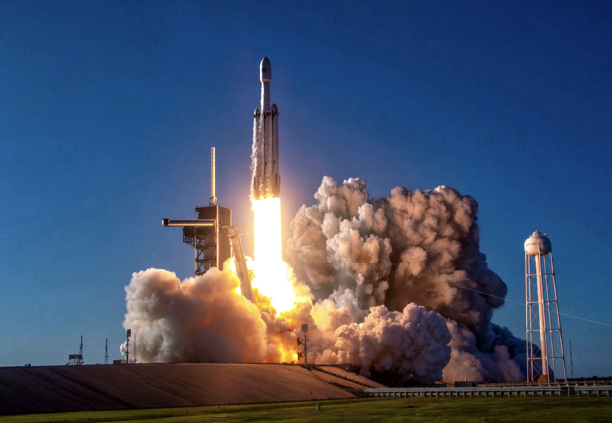USSF National Security Space Launch Phase 3 —
A New Lane To Encourage Innovation and Growth
With the selection of three launch providers for the newest iteration of National Security Space Launch (NSSL), and the opportunity for additional “on-ramps” for other emerging space companies, Space Systems Command’s Assured Access to Space (AATS) organization is taking U.S. Space Force (USSF) launches to the next level.
 NSSL 86 SBIRS GEO-5 Atlas V.
NSSL 86 SBIRS GEO-5 Atlas V.
“Phase 3 is an important next step for driving space launch resilience in the continued evolution of our NSSL program,” said USSF Brig. Gen. Kristin Panzenhagen, Space Systems Command’s quad-hatted program executive officer for Assured Access to Space (AATS); Commander, Space Launch Delta (SLD) 45; Director of the Eastern Range; and Director of Launch and Range Operations. “It offers more flexibility for getting critically important space capabilities on orbit while also encouraging a robust space launch industrial base.”
NSSL is a USSF program designed to provide assured access to space for the Department of Defense (DoD) and other U.S. national security payloads. SSC’s AATS organization manages the program, which launches satellites for NSSL, the USSF, as well as other organizations such as the Missile Defense Agency, Space Development Agency and the National Reconnaissance Office.
“Because NSSL payloads are vital to securing U.S. interests in space and defending our Nation, mission success is vitally important,” said USSF Col. Jim Horne, Launch Execution Delta Commander. “It is also becoming increasingly important to balance the need to deliver capability at pace for Great Power Competition; accepting appropriate risk. To ensure mission success, we have very stringent requirements for providers launching high value, non-risk tolerant missions, but we’re excited to start creating avenues that allow us to adjust mission assurance for more risk tolerant payloads and leverage innovation in the expanding industrial base.”
Unlike previous iterations, such as NSSL Phase 2 launched in 2020, NSSL’s Phase 3 includes two lanes: Lane 1 covers less-demanding missions with higher risk tolerance and is designed to encourage new launch providers with annual “on ramps.” Lane 2 requires each provider to be able to handle the most challenging NSSL requirements.
“Phase 2 was ground-breaking on its own because it marked the first time in twenty years the United States had two independent providers of launch vehicles that could meet NSSL requirements,” Horne said. “With Phase 3, we look forward to increasing this even further, and have an additional Lane designed to help other innovative companies grow and mature.”
Bonnie Triezenberg, policy analyst and senior engineer at the RAND Corporation, a nonprofit, public policy, research organization, said Phase 3 was a good progression for USSF NSSL, but noted that, despite technological progress in the commercial space industry, space launch is still extremely difficult.
“It’s just tremendously difficult to make a repeatable, reliable launch vehicle,” Triezenberg said. “It’s mostly the engines where people get stuck in manufacturing, but it’s also putting the whole rocket together around that engine. When (RAND) did its 2019 launch study, we looked ahead to 2024 and projected there would be 19 different launch vehicles capable of taking you to orbit.
We haven’t reached that number yet.
 NSSL 90 — NROL-87 (the last A-6S) FalconBlock 5 NRO
NSSL 90 — NROL-87 (the last A-6S) FalconBlock 5 NRO
“When we did our study, we recommended that the USSF try to support a wide number of providers to come into the market because we were looking ahead and saying in 2023 and 2024, it looks like we’re going to have a shortage of launch vehicles,” Triezenberg said. “Phase 3, Lane 1 is a good attempt. They’ve identified the set of launch vehicles for which they have more risk tolerance, and for which they’re willing to lower some of the fairly stringent standards they’ve traditionally had for national security space launch.”
For decades, only large countries, such as the United States and the Soviet Union, had the funding, engineering capacity, and infrastructure to conduct space launches.
Through block-buy economic ordering quantities, on-ramping competition, and implementing innovations, the NSSL program has greatly reduced the cost of U.S. space launch.
Commercial space companies have also helped bring the cost of space launch down, making it more affordable for contenders.
In June, the DOoD announced that SpaceX, Blue Origin, and United Launch Alliance (ULA) were selected to compete for the initial onboarding of NSSL Lane 1. There will be annual onboarding opportunities for contracts for Lane 1 launches across fiscal years 2025 through 2029.
The launch vehicles for Phase 3, Lane 1, include SpaceX’s Falcon 9, Blue Origin’s New Glenn and ULA’s Vulcan Centaur, all heavy-lift vehicles capable of delivering payloads to orbits that include LEO, GEO and polar.
Launch vehicles for Lane 1 could also include medium-lift rockets or multiple launches capable of placing at least 15,000 pounds of payload mass into LEO.
Contenders would need to demonstrate that their systems are mature and be able to demonstrate launch capability that will meet mission needs in 12 months from award. Lane 1 will include at least 30 missions to LEO.
“What’s exciting about this is, as we move into the future space architecture, we’re going to have multiple types of missions,” said USSF Col. Douglas Pentecost, SSC’s deputy program executive officer for Assured Access to Space. “We’re going to have the critical, super- secret, billion-dollar payloads that are going to unique, military-only orbits, but we also have a bunch of proliferated constellations being developed that are going to be all around LEO.
 NSSL 93 — SBIRS GEO-6 Atlas V
NSSL 93 — SBIRS GEO-6 Atlas V
“That’s really what we’re trying to get at with these Lane 1 capabilities -- new providers can come on and bring whatever technology or innovation they can bring, and get us lower launch costs and more launches,” Pentecost said. “If you go back even just a couple of years ago, we were launching maybe five times a year, military satellites. Looking at next year, we have 25 that we’re hoping to launch. Having more providers that can get our capabilities into space is good for us and for the Nation.”
“What we’re learning with today’s Great Power Competition is having multiple, diverse ways into space, multiple locations to launch from, will be key to whatever future challenges we have,” Pentecost said. “What Lane 1 and Lane 2 have allowed us to do is increase our stable of launch vehicles and locations that we can launch from to be able to provide to the warfighter the needed delivery of capability.”
USSF Col. Chad Melone, senior materiel leader for SSC’s Mission Solutions Space Acquisition Delta, said that while Lane 1 space launch providers won’t be held to the same exacting standards as Lane 2, Lane 1 is still part of USSF’s overall strategy for NSSL launches, and provides assured access to space and mission assurance in a different way.
“Lane 1 is for the DoD’s missions that are more commercial-like,” Melone said. “It allows companies that are already going after the commercial market to go after that portion of the DoD’s mission set that is most similar to those commercial missions. So they don’t have to change anything to be able to compete for those missions.
“We designed Lane 1 the way we did, in order to be able to leverage the innovation, the price competition, the diversity of those commercial systems for the DoD’s mission set. Companies can on-ramp on an annual basis, whenever they are ready, when they have launched those systems that they are out there developing, and they can do it from any geographic location.
“Lane 1 comes at assured access to space in a different way than just having two launch providers in two locations for every single design reference mission (a plan used to guide early development efforts0 that was part of Phase 2,” Melone noted. “These space launch vehicles are smaller, lighter, less expensive and easier to replace (than the heavy lift rockets of Lane 2) and that means more than one provider naturally will be able to do that.
“So just like when a commercial satellite operator puts out a request for proposal to launch its own satellite, there might be a Rocket Lab or Relativity or ABL that might bid on that. We’re looking to take advantage of that same sort of diversity for Lane 1, so we get assured access to space, but in a different way than in its traditional meaning.
“Typically, emerging launch providers are striving for excellence. They can’t stay in business long-term if they’re not successfully delivering capabilities into space. So, we know they are incorporating a lot of their own mission-assurance type work when they do the work that they do.
“Lane 1 also includes multiple levels of mission assurance – the full lifecycle process providing confidence to proceed. The missions that are on Lane 1 can choose the mission assurance tier that is most relevant for them. That gives those companies an opportunity to start with missions that have lower levels of mission assurance, and then graduate up to increasing levels of mission assurance, so that one day, if they have the desire, they can compete for a Lane 2 in the future.
“In the commercial world, there’s been a similar shift to include proliferated architectures. Companies are responding to a commercial demand signal for medium-lift space vehicles. We know the DoD is not going to have a set satellite architecture – it will evolve over time. In the past, the systems were very large, expensive – and they were hard to deliver to the locations where they needed to be.”
“There is shift now to include these proliferated architectures, and launch operators are building systems to respond to that,” Melone added. “We still have these very large missions that are going to need things like direct inject to Geosynchronous Orbit, which commercial doesn’t typically do. And we’re going to need providers who have those very robust capabilities. But we also recognize that if there’s an opportunity to partner to win these other companies, on a much more tight-turn approach, that’s what Lane 1 is all about. I think it very much supports Chief of Space Operations Gen. B. Chance Saltzman’s view for Partnering to Win,” Melone concluded.
 NSSL 95 USSF-44 Falcon Heavy
NSSL 95 USSF-44 Falcon Heavy
In addition to the tiered mission assurance, Phase 3 also will include rideshare, Pentecost said; again, matching what occurs in the commercial marketplace to bring the cost of launch down.
“If you want to make it long-term in this business, you must that government market, you must o have someone with deep pockets who can bring you through the tough times – or even get you started,” Triezenberg said. “A lot of people think that SpaceX never had any government support and this is absolutely wrong. You need seed money, you need support.“Until you get those successful launches under your belt, almost anything can go wrong — and almost everything does go wrong. When you look across the delays that each of the different companies have had as they try to bring their launch vehicles to market, there’s not a lot of similarity there. They all go wrong in different ways and it just takes a long time to get a new launch vehicle into the market.”
“In this era of Great Power Competition, and with so much of our nation’s way of life depending on U.S. space assets, having assured access to space is more important than ever,” Panzenhagen said. “With the help of our commercial space industry partners, we’re looking forward to becoming more resilient, cost-effective and efficient, and to delivering capabilities to the warfighter whenever and wherever they are most needed.”
Space Systems Command is the U.S. Space Force field command responsible for acquiring, developing, and delivering resilient capabilities to protect our nation’s strategic advantage in, from, and to space. SSC manages a $15.6 billion space acquisition budget for the Department of Defense and works in partnership with joint forces, industry, government agencies, academic and allied organizations to outpace emerging threats. Our actions today are making the world a better space for tomorrow.
For additional information, contact Space Systems Command at SSC@spaceforce.mil and/or follow on LinkedIn.
Author Lisa Sodders writes the monthly Space Systems Command column for MilsatMagazine.
All imagery in this feature is courtesy of Space Systems Command.

